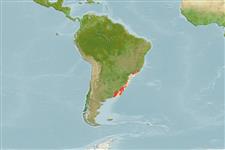Brevoortia aurea (Spix & Agassiz, 1829)
Brazilian menhaden
Beobachtung melden im Fish Watcher
| Native range | All suitable habitat | Point map | Year 2050 |

|
| This map was computer-generated and has not yet been reviewed. |
| Brevoortia aurea AquaMaps Data sources: GBIF OBIS |
Hochladen Photos und videos
Pictures | Google BildBrevoortia aurea
Picture by Timm, C.D.
Pictures | Google BildBrevoortia aurea
Picture by Timm, C.D.
Argentina country information
Common names:
Lacha, Saraca
Occurrence: native
Salinity: freshwater
Abundance: | Ref:
Importance: | Ref:
Aquaculture: | Ref:
Regulations: | Ref:
Uses: no uses
Comments: Found in Punta Lara, La Plata (Ref. 51923). Probably ranging to Rio de la Plata (but needs confirmation) (Ref. 188). Also Ref. 9086, 27363.
National Checklist: Argentina
Country Information: https://www.cia.gov/library/publications/resources/the-world-factbook/geos/ar.html
National Fisheries Authority:
Occurrences: Occurrences Point map
Main Ref: Whitehead, P.J.P., 1985
National Database:
Occurrence: native
Salinity: freshwater
Abundance: | Ref:
Importance: | Ref:
Aquaculture: | Ref:
Regulations: | Ref:
Uses: no uses
Comments: Found in Punta Lara, La Plata (Ref. 51923). Probably ranging to Rio de la Plata (but needs confirmation) (Ref. 188). Also Ref. 9086, 27363.
National Checklist: Argentina
Country Information: https://www.cia.gov/library/publications/resources/the-world-factbook/geos/ar.html
National Fisheries Authority:
Occurrences: Occurrences Point map
Main Ref: Whitehead, P.J.P., 1985
National Database:
Common names from other countries
Klassifizierung / Names Namen | Synonyme | Catalog of Fishes(Gattung, Arten) | ITIS | CoL | WoRMS | Cloffa
> Clupeiformes (Herrings) > Alosidae (Shads and Sardines)
Etymology: Brevoortia: From James Carson Brevoort (1818-1887), studie the fauna from Ohio and South Caroline (Ref. 45335).
Eponymy: James Carson Brevoort (1818–1887) was an American collector of coins and rare books. [...] (Ref. 128868), visit book page.
More on authors: Spix & Agassiz.
Etymology: Brevoortia: From James Carson Brevoort (1818-1887), studie the fauna from Ohio and South Caroline (Ref. 45335).
Eponymy: James Carson Brevoort (1818–1887) was an American collector of coins and rare books. [...] (Ref. 128868), visit book page.
More on authors: Spix & Agassiz.
Environment: milieu / climate zone / depth range / distribution range Ökologie
seewasser. Subtropical; 22°S - 38°S, 60°W - 42°W (Ref. 188)
Verbreitung Länder | FAO Gebiete | Ecosystems | Vorkommen | Point map | Einführungen | Faunafri
Southwest Atlantic: Rio de Janeiro, Brazil probably to mouth of Rio de la Plata, Argentina (needs confirmation).
Size / Gewicht / Alter
Kurzbeschreibung Bestimmungsschlüssel | Morphologie | Morphometrie
Rückenflossenstacheln (insgesamt) : 0; Afterflossenstacheln: 0. Scutes apparent along belly. Upper jaw with distinct median notch. Pectoral fin tip short of pelvic fin base by width of 3 to 7 scales; pelvic fin with oblique and almost straight hind margin. Pre-dorsal scales modified; scales on back and above base of anal fin not markedly smaller than rest. A black spot behind gill opening, but none along flank.
Forms schools (Ref. 188). The morphological characteristics observed and the composition of the trophic spectrum indicate that this species is a filter-feeder, consuming mainly phytoplankton (Ref. 34154).
Life cycle and mating behavior Geschlechtsreife | Fortpflanzung | Ablaichen | Eier | Fecundity | Larven
Hauptreferenz
Upload your references | Referenzen | Koordinator | Partner
Whitehead, P.J.P., 1985. FAO Species Catalogue. Vol. 7. Clupeoid fishes of the world (suborder Clupeoidei). An annotated and illustrated catalogue of the herrings, sardines, pilchards, sprats, shads, anchovies and wolf-herrings. FAO Fish. Synop. 125(7/1):1-303. Rome: FAO. (Ref. 188)
IUCN Rote Liste Status (Ref. 130435: Version 2024-2)
nicht bedroht (LC) ; Date assessed: 06 March 2017
Bedrohung für Menschen
Harmless
Nutzung durch Menschen
Fischereien: kommerziell
FAO(Fischereien: production; publication : search) | FishSource | Sea Around Us
Mehr Information
Population dynamics
Growth parameters
Max. ages / sizes
Length-weight rel.
Length-length rel.
Längenhäufigkeiten
Mass conversion
Rekrutierung
Dichte
Growth parameters
Max. ages / sizes
Length-weight rel.
Length-length rel.
Längenhäufigkeiten
Mass conversion
Rekrutierung
Dichte
Life cycle
Fortpflanzung
Geschlechtsreife
Fecundity
Ablaichen
Spawning aggregations
Eier
Eientwicklung
Larven
Larven Pop.Dyn.
Fortpflanzung
Geschlechtsreife
Fecundity
Ablaichen
Spawning aggregations
Eier
Eientwicklung
Larven
Larven Pop.Dyn.
Anatomy
Kiemenoberfläche
Brain
Otolith
Kiemenoberfläche
Brain
Otolith
Physiology
Body composition
Nutrients
Oxygen consumption
Swimming type
Swimming speed
Visual pigments
Fish sound
Diseases & Parasites
Toxicity (LC50s)
Body composition
Nutrients
Oxygen consumption
Swimming type
Swimming speed
Visual pigments
Fish sound
Diseases & Parasites
Toxicity (LC50s)
Human related
Aquaculture systems
Aquakultur Profile
Zuchtlinien
Ciguatera cases
Stamps, coins, misc.
Aquaculture systems
Aquakultur Profile
Zuchtlinien
Ciguatera cases
Stamps, coins, misc.
Tools
E-book | Feldführer | Längenhäufigkeits Tool | Lebensdaten Tool | Punkt Karte | Classification Tree
| Catch-MSY |
Zusatzinformationen
Download XML
Zusammenfassung | Point data | Namen | Photos
Internet Quellen
Aquatic Commons | BHL | Cloffa | BOLDSystems | Websites from users | FishWatcher Einträge suchen | CISTI | Catalog of Fishes(Gattung, Arten) | DiscoverLife | ECOTOX | Faunafri | Fishtrace | GenBank(Genom, nucleotide) | GloBI | GOBASE | | Google Books | Google Scholar | Google | IGFA World Record | MitoFish | Nationale Datenbanken | Otolith Atlas of Taiwan Fishes | PubMed | Reef Life Survey | Scirus | SeaLifeBase | Tree of Life | Wikipedia(Gehe zu, Suchen) | World Records Freshwater Fishing | Zoological Record
Estimates based on models
Preferred temperature (Ref. 115969): 12.6 - 22.8, mean 16.8 (based on 104 cells).
Phylogenetic diversity index (Ref. 82804): PD50 = 0.5156 [Uniqueness, from 0.5 = low to 2.0 = high].
Bayesian length-weight: a=0.00457 (0.00181 - 0.01153), b=3.12 (2.90 - 3.34), in cm Total Length, based on LWR estimates for this (Sub)family-body shape (Ref. 93245).
Trophic level (Ref. 69278): 2.8 ±0.31 se; based on food items.
Widerstandsfähigkeit (Ref. 120179): hoch, Verdopplung der Population dauert weniger als 15 Monate. (Assuming tm=1).
Fishing Vulnerability (Ref. 59153): Low vulnerability (24 of 100).
Climate Vulnerability (Ref. 125649): Very high vulnerability (79 of 100).




